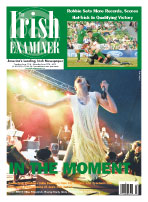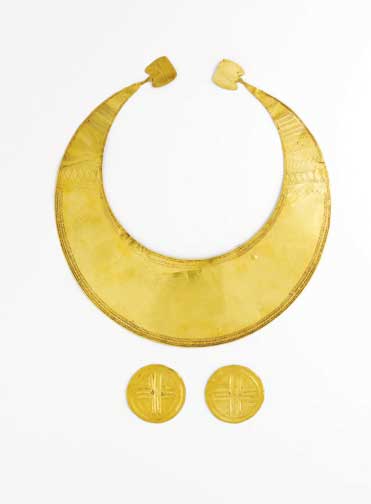


SERVICES
Tuesday June 29, 2010
Robbers Dump Priceless Gold Treasure
Two gold discs and a gold lunula from Coggalbeg, Co. Roscommon Ref 0036 (National Museum of Ireland) Recovered Artefacts Go On Display At MuseumAn extraordinary sequence of events led to a collection of 4,000-year-old gold jewellery going on display at the National Museum of Ireland this week. They include the robbery of a rural chemist, the unknowing discarding of priceless loot by criminals and a race against time to prevent the dumped Treasure being lost forever, as Vincent Murphy reports.Farmer Hubert Lannon was cutting turf in his bog when he made an unusual discovery. It was March 1945, and the place was Coggalbeg, Co Roscommon. As he turned the sod, he found three tiny pieces of gold jewellery. Two small gold discs, and a bigger crescent-shaped collar. Over 65 years later, those precious pieces of ancient craftwork have gone on display for the first time at the National Museum of Ireland in Dublin. It's been described as the most important discovery of early Bronze Age gold-work in Ireland for many, many years. But even more amazing than the treasure itself, is the story of how it was almost lost. Hubert Lannon held onto the jewellery for two years, but in 1947 he gave it to his local chemist Patrick Sheehan in Strokestown. Mr Sheehan put it into his safe, where it remained locked away safely. Neither man realised the value of what they had discovered. Nor did Patrick Sheehan's daughter Sunniva, who continued to store the jewellery in the safe after his death in the 1960s. Hubert Lannon died at the age of 92 last year - just weeks before his golden hoard would re-emerge in dramatic circumstances. On the night of March 27th 2009, as Sunniva Sheehan slept in the residence adjoining the family pharmacy, two Dublin men with a history of violent crime and drug abuse, drove into Strokestown. Anthony Dowling and Robert Dempsey were in all likelihood looking for drugs when they targeted the pharmacy for an opportunistic robbery. Dempsey used his shoulder to bust open the door of the shop, and went inside, while Dowling stood at the doorway, acting as a lookout. They took what they could - including the entire safe which held the jewels inside. They drove back to Dublin through the night - CCTV cameras filmed their car driving through a toll plaza at around 5am. Gardai would later use that footage to track their movements to Rueben Street in the Dublin suburb of Finglas. Back in Roscommon, the Sheehan family were dealing with the fall-out from their robbery. They told investigating Gardai that in addition to family documents and other belongings, the safe containing the gold jewellery found in a bog more than 65 years earlier. Gardai contacted curators from the National Museum and with the description provided by the Sheehan family, identified that the objects were mostly likely gold ornaments from the Early Bronze Age. The discs and necklaces were thin, flat and extremely light, weighing just 2.5 ounces in total. And they were being kept inside an envelope in the safe. It soon became clear that this treasure might have been missed completely when the robbers looked inside the safe. And indeed it eventually probed to be the case. Gardai investigating the case discovered that Dowling and Dempsey had thrown the envelope into a black bin bag, which they dumped in a rubbish skip. The two men had no idea of the value of what they had stolen, but helped to locate them when they were told that they were of "national significance". The only trouble was - that by now, the refuse was due to be collected within hours - and so began a race against time to recover the precious metals. A protection order was placed on the bin and its contents were removed to a Garda station where two detectives searched through its contents. It was a messy job - but inside they found the envelope and the 4,000 year old jewellery - completely undamaged. The gold discs were two of just 21 known to exist, and it was the only time that they had been found together with the gold necklace, known as a lunula. Museum experts say that's archaeologically significant - as it suggests a previously unknown overlap in the styles of gold work in the period of about 2300BC to 2000BC. The jewellery was handed over to the National Museum who carried out investigations into the pieces, and prepared to put them on exhibition. Director of the National Museum, Dr Pat Wallace said, they were able to conclude that the artefacts were "made together from the same piece of gold, and probably in Co. Roscommon". Dowling and Dempsey pleaded guilty in court earlier this year, and were given suspended sentences. The judge told them that while he would stop short of recommending a finders reward, he would give them some credit for co-operating with Gardai and ensuring the treasures were found. The court heard that Dempsey had visited the National Museum since the robbery to view the treasures he had dumped. Now, the general public can view them too. The hoard has been put on display at the National Museum in Kildare Street, Dublin, where admission to all exhibitions is always free. |
CURRENT ISSUE

RECENT ISSUES


SYNDICATE
[What is this?]
POWERED BY

HOSTED BY

Terms of Service | Privacy Policy
Website Design By C3I






